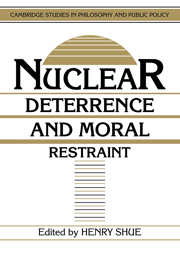Book contents
- Frontmatter
- Contents
- Preface
- Notes on contributors
- Introduction
- 1 Having it both ways: the gradual wrong turn in American strategy
- 2 Finite counterforce
- 3 Deterrence and the moral use of nuclear weapons
- 4 Escaping from the bomb: immoral deterrence and the problem of extrication
- 5 The necessary moral hypocriy of the slide into mutual assured destruction
- 6 Finite deterrence
- 7 Defending Europe: toward a stable conventional deterrent
- 8 The case for deploying strategic defenses
- 9 Morality, the SDI, and limited nuclear war
- Index
8 - The case for deploying strategic defenses
Published online by Cambridge University Press: 26 January 2010
- Frontmatter
- Contents
- Preface
- Notes on contributors
- Introduction
- 1 Having it both ways: the gradual wrong turn in American strategy
- 2 Finite counterforce
- 3 Deterrence and the moral use of nuclear weapons
- 4 Escaping from the bomb: immoral deterrence and the problem of extrication
- 5 The necessary moral hypocriy of the slide into mutual assured destruction
- 6 Finite deterrence
- 7 Defending Europe: toward a stable conventional deterrent
- 8 The case for deploying strategic defenses
- 9 Morality, the SDI, and limited nuclear war
- Index
Summary
INTRODUCTION
In a landmark speech on March 23, 1983, President Reagan called for a major national effort aimed at exploring the feasibility and effectiveness of active defenses against ballistic missiles. The speech has been hailed by some and condemned by others as signaling a revolutionary change in U.S. strategy. This characterization is greatly exaggerated. However, the speech did reopen a major debate over the role of defense in the U.S. strategic posture – a subject that had been neglected for more than a decade.
The first concrete outcome of Reagan's address was the launching of the Strategic Defense Initiative as a well-funded, comprehensive research program. SDI has become highly controversial, for it appears to challenge conventional wisdom about nuclear strategy while at the same time introducing new complications in NATO relations and arms control negotiations. It also promises to be extremely expensive.
The purpose of this chapter is to provide a strategic – not a moral or ethical – rationale for strategic defenses. It makes the case for a U.S. strategy that includes such defenses, but not for replacing offense with defense. Nor does it suggest that a deterrent that seeks to deny an aggressor confidence in achieving his military objectives can wholly supplant the threat of retaliation. Thus, the approach advocated here differs in emphasis from the long-range goals that were advanced by President Reagan.
To provide some context for the discussion, I first review current U.S. national security policy and strategy. Next, the role of nuclear weapons is examined, focusing on current strategy and possible alternatives, including one option – finite deterrence – that is the subject of another chapter in this volume.
- Type
- Chapter
- Information
- Nuclear Deterrence and Moral RestraintCritical Choices for American Strategy, pp. 343 - 380Publisher: Cambridge University PressPrint publication year: 1989



